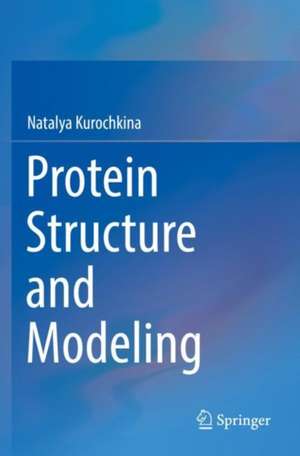Protein Structure and Modeling
Autor Natalya Kurochkinaen Limba Engleză Paperback – 14 aug 2020
| Toate formatele și edițiile | Preț | Express |
|---|---|---|
| Paperback (1) | 891.46 lei 38-44 zile | |
| Springer Nature Singapore – 14 aug 2020 | 891.46 lei 38-44 zile | |
| Hardback (1) | 1110.72 lei 3-5 săpt. | |
| Springer Nature Singapore – 17 iun 2019 | 1110.72 lei 3-5 săpt. |
Preț: 891.46 lei
Preț vechi: 1172.98 lei
-24% Nou
Puncte Express: 1337
Preț estimativ în valută:
170.60€ • 177.03$ • 142.59£
170.60€ • 177.03$ • 142.59£
Carte tipărită la comandă
Livrare economică 13-19 martie
Preluare comenzi: 021 569.72.76
Specificații
ISBN-13: 9789811366031
ISBN-10: 9811366039
Pagini: 276
Ilustrații: VIII, 276 p. 81 illus., 60 illus. in color.
Dimensiuni: 155 x 235 mm
Greutate: 0.52 kg
Ediția:1st ed. 2019
Editura: Springer Nature Singapore
Colecția Springer
Locul publicării:Singapore, Singapore
ISBN-10: 9811366039
Pagini: 276
Ilustrații: VIII, 276 p. 81 illus., 60 illus. in color.
Dimensiuni: 155 x 235 mm
Greutate: 0.52 kg
Ediția:1st ed. 2019
Editura: Springer Nature Singapore
Colecția Springer
Locul publicării:Singapore, Singapore
Cuprins
CHAPTER 1 - Protein Structure
1.1 Polypeptide chain
1.2 Ligand binding
1.3 Active site
1.3 Structure-function
CHAPTER 2 - Conformational transitions
2.1 Types of transitions in molecular systems
2.2 Conformational states
2.3 Quantum motions
2.4 Myoglobin and hemoglobin
2.5 Cytochromes
2.6 Tobacco mosaic virus coat protein
2.7 Fibrin-fibrinogen
2.8 Conformational changes of side chains in protein interior as a basis of the conformational states of the molecule
CHAPTER 3 – Allosteric regulation
3.1 Proteins
3.2 Nucleic acids
3.3 Small ligands
CHAPTER 4 – Protein channels
4.1 Structure-function
4.2 Signaling
CHAPTER 5 - Helical assemblies
5.1 Determinants of specific helix recognition
5.2 Types of assemblies
CHAPTER 6 - multiprotein complexes
6.1 Postsynaptic density
6.2 Viruses
6.3 Implications in signaling
CHAPTER 7 - Methods of structure determination
7.1 X-Ray crystallography, NMR and Electron Microscopy
7.2 NMR
7.3 Electron Microscopy
CHAPTER 8 – Protein modeling
8.1 Helix and its interactions
8.2 Ligands
8.3 Dynamics
References
Dictionary
1.1 Polypeptide chain
1.2 Ligand binding
1.3 Active site
1.3 Structure-function
CHAPTER 2 - Conformational transitions
2.1 Types of transitions in molecular systems
2.2 Conformational states
2.3 Quantum motions
2.4 Myoglobin and hemoglobin
2.5 Cytochromes
2.6 Tobacco mosaic virus coat protein
2.7 Fibrin-fibrinogen
2.8 Conformational changes of side chains in protein interior as a basis of the conformational states of the molecule
CHAPTER 3 – Allosteric regulation
3.1 Proteins
3.2 Nucleic acids
3.3 Small ligands
CHAPTER 4 – Protein channels
4.1 Structure-function
4.2 Signaling
CHAPTER 5 - Helical assemblies
5.1 Determinants of specific helix recognition
5.2 Types of assemblies
CHAPTER 6 - multiprotein complexes
6.1 Postsynaptic density
6.2 Viruses
6.3 Implications in signaling
CHAPTER 7 - Methods of structure determination
7.1 X-Ray crystallography, NMR and Electron Microscopy
7.2 NMR
7.3 Electron Microscopy
CHAPTER 8 – Protein modeling
8.1 Helix and its interactions
8.2 Ligands
8.3 Dynamics
References
Dictionary
Textul de pe ultima copertă
The volume covers the advances made by the most recent experimental and theoretical research in the structure of the most extensively studied main biological macromolecules - the proteins. Proteins are remarkably regular highly ordered biopolymers. Their precise organization allows living organisms to reliably perform complex functions.
The book features an introduction into methods of protein structure determination, design, and modeling, and addresses the structural principles of fibrous and globular proteins such as enzymes, channels, signaling molecules and adaptors, and the relationships between primary, secondary, tertiary, and quaternary structure. The main focus is on determinants of protein conformation, canonical and noncanonical amino acids and polypeptides, conformational states and transitions, structure elements and arrangements, protein folds, helical assemblies, multiprotein complexes, structure and function relationships, the specificity of molecular recognition, ligand binding, and involvement in cellular processes. The book is a must read for scientists, engineers, teachers, undergraduate and graduate students, business professionals, and curious learners in the fields of Life Sciences and Biomedical Research.
Prof. Natalya Kurochkina heads The School of Theoretical Modeling, Washington, DC, USA, teaches, and conducts research. She has PhD in Biophysics, from the Institute of Protein Research, Russian Academy of Sciences and worked as a postdoctoral fellow at the National Cancer Institute of the National Institute of Health. Her research focuses on principles of protein structure and protein conformation, and determinants of specificity of molecular recognition
The book features an introduction into methods of protein structure determination, design, and modeling, and addresses the structural principles of fibrous and globular proteins such as enzymes, channels, signaling molecules and adaptors, and the relationships between primary, secondary, tertiary, and quaternary structure. The main focus is on determinants of protein conformation, canonical and noncanonical amino acids and polypeptides, conformational states and transitions, structure elements and arrangements, protein folds, helical assemblies, multiprotein complexes, structure and function relationships, the specificity of molecular recognition, ligand binding, and involvement in cellular processes. The book is a must read for scientists, engineers, teachers, undergraduate and graduate students, business professionals, and curious learners in the fields of Life Sciences and Biomedical Research.
Prof. Natalya Kurochkina heads The School of Theoretical Modeling, Washington, DC, USA, teaches, and conducts research. She has PhD in Biophysics, from the Institute of Protein Research, Russian Academy of Sciences and worked as a postdoctoral fellow at the National Cancer Institute of the National Institute of Health. Her research focuses on principles of protein structure and protein conformation, and determinants of specificity of molecular recognition
Caracteristici
Maximizes reader insights into the most recent advancements in understanding the structure of proteins
Incorporates a wealth of the most recent experimental and theoretical research in the field
Includes an introduction into methods of protein structure determination, design, and modeling
Incorporates a wealth of the most recent experimental and theoretical research in the field
Includes an introduction into methods of protein structure determination, design, and modeling
